|
June Article
|
Butterflies Create Happiness One Caterpillar at a Time
It's finally summer in Minnesota! One of the major
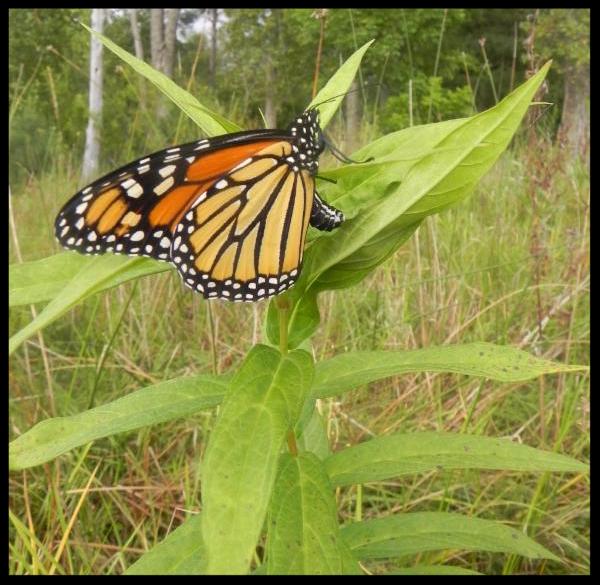
advantages of having native plants dominate your natural shore, prairie, or garden area is the likelihood of brilliantly colored butterflies becoming frequent visitors.
Adult butterflies are attracted to the nectar and pollen that native plants offer. Certain insect species must find specific host plant species on which to lay their eggs and feed their young. Are you thinking of the monarch butterfly? This insect's life cycle and dependence on milkweed is often first introduced in elementary school curriculum. We know monarchs must lay their eggs on milkweed species in order for their caterpillars to survive
.
Likewise, other butterfly species have specific plants which they must lay their eggs
on
in order for their caterpillars to survive and grow. Therefore, a diversity of native plant species will likely attract a diversity of butterflies, undoubtedly increase your happiness, as you enjoy both the colorful plants and their beautiful visitors. Here are a few caterpillars you might see on your native plants!
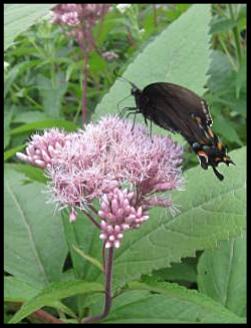
If you plant golden alexanders (
Zizia aurea), you are providing the host plant for the black swallowtail butterfly (
Papilio polyxenes). Golden alexanders green-up early spring, providing food for hungry caterpillars that are newly hatched. Most often the background color of this caterpillar is pale green and can be distinguished by black bands containing six little yellow spots. Golden alexanders have clusters of bright yellow flowers; thus the caterpillar's markings work well as camouflage. Look closely and you will find them munching on the dark green leaves in June.
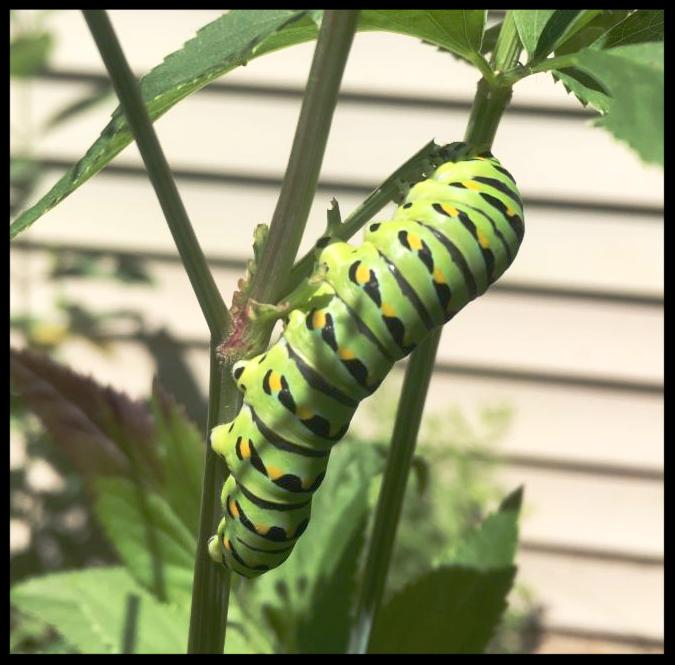
The swallowtail caterpillar remains in the larval stage up
to one month and grows to four centimeters. After being in a chrysalis for approximately 10 days, an adult emerges. In our Minnesota climate there are two, sometimes three broods during the growing season. If you don't see the swallowtail caterpillar in June, keep watching and you may spot another brood in August.
 Purple prairie clover (
Dalea purpurea) plays host for the southern dogface butterfly (
Zerene cesonia). Purple prairie clover might have small leaves, but they make a fine meal for these caterpillars, which have a green base and a yellow lateral stripe running the length of its body. Black and yellow bands develop at each segment as the caterpillar matures to nearly three centimeters.
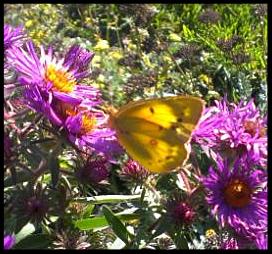
Watch carefully for this species, as southern dogface butterflies might only produce one brood a year in the northern states. Here in Minnesota, we are on the periphery of this butterfly's range.
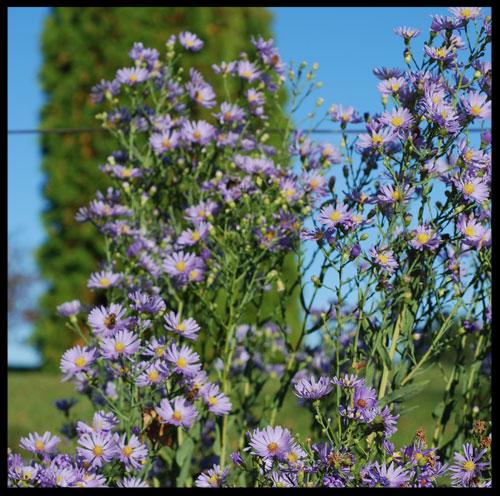 Smooth blue aster (
Aster laevis) plays host to the spiny little caterpillar of the pearl crescent butterfly (
Phyciodes tharos). Less than two centimeters long, this bristly caterpillar is mostly brown with tiny white spots and eight rows of spines. Watch for clusters of these little ones on your asters as they tend to feed in groups.
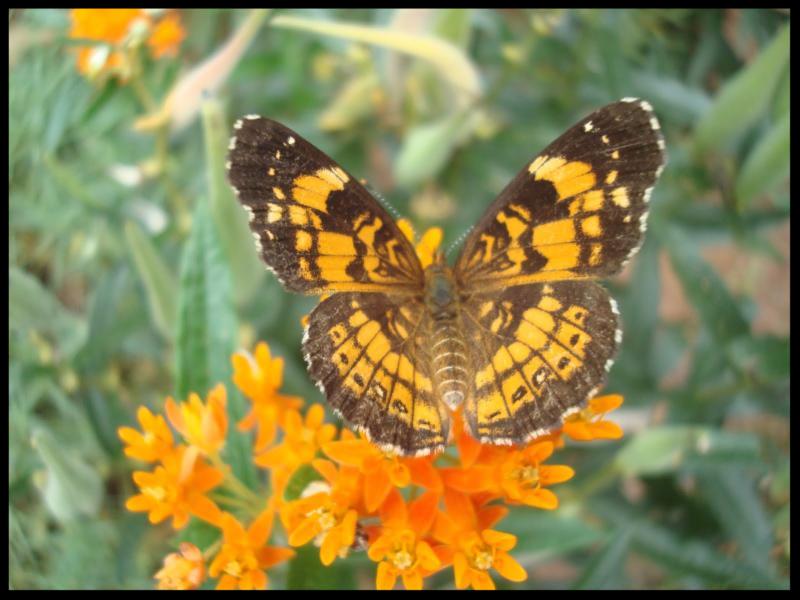
After two weeks of active feeding, the pearl crescent caterpillar forms a chrysalis, and then takes two weeks before emerging as an adult. There are several broods during the growing season, providing ample opportunities for you to spot them out for friends.
Butterfly gardening has really gained in popularity over the last few years. Thankfully, more and more people are piecing together the importance of native plant species to insect life cycles. Often, we are seeing that this hobby leads to folks becoming interested in ecological restoration, where it is possible to provide multiple habitat types for a wide range of animals. So whether you are starting with a garden or looking at a 10 acre restoration, we at Natural Shore are here to help. We would love to assist you with a multi-faceted approach to establish diverse native plant communities that attract more butterflies and beneficial pollinators to your property. Ask us how!
|
|
Native Plant of the Month
|
Horsemint 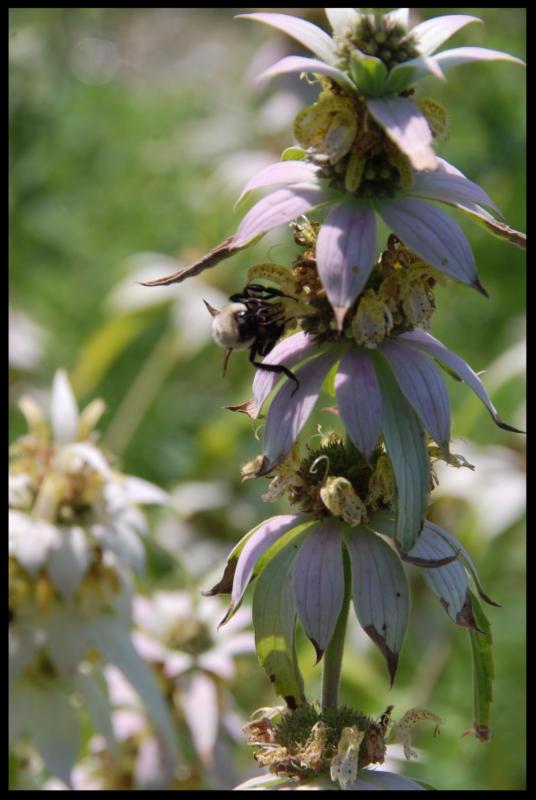
Monarda punctata
Moisture: Dry
Exposure: Full Sun or Partial Shade
Blooms: July-September
Color: Lavender
Height: 0.5-3 Feet
Horsemint is a clump-forming plant with hairy square stems and leaves. It is a very aromatic plant that smells like oregano. The dull yellow flowers have purple spots, are tubular, and arranged in small compact heads subtended by a whorl of pink to purple-tinged showy leafy bracts. The bract-supported flower heads are arranged in several tiers on the flower stalk. This species has greater tolerance of drought than other Monarda species. It grows in full sun, part sun, and is tolerant of poor soils. They are found in dry soils of prairies, sandy areas, and coastal plains. Their flowers are visited for nectar and pollen by bees and for nectar by hummingbirds. Other common names are dotted horsemint, spotted horsemint, and spotted bee balm.
|
|
Invasive Plant of the Month
|
Cypress Spurge

Euphorbia cyparissias
Moisture: Dry
Exposure: Full Sun or Partial Shade
Blooms: May-August
Color: Yellow
Height: 0.5-1 Foot
Also known as graveyard weed, this perennial is a weed from Europe. It is often found in areas with disturbed soils like roadsides or open fields. It looks very similar to leafy spurge but is shorter, more densely clustered, and blooms earlier. The leaves are short and narrow, making the plant look like a baby evergreen tree. The leaves, stems, and branches are a light green and excrete a latex substance when broken. Flowers are a yellowish-green and found in clusters on the stem. This plant forms dense colonies and can take multiple years to manage. Herbicide treatments, mowing, and hand pulling are effective ways to control infestations.
|
Eastern Tiger Swallowtail 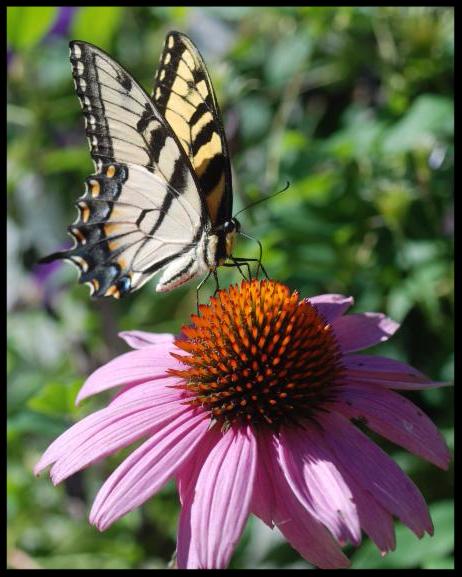
Papilio glaucus
Range
: Throughout Eastern half of North America
Identification
: Males are yellow with black stripes while females can be either yellow with black stripes or dark black and blue.
They also have small red spots on their wing margins.
Pollination: Swallowtails adults love to eat nectar from many different native plant species including coneflower species, milkweed species, joe pye weed, bergamot, liatris species, and many more!
|
|
|
Come visit us! Check out our 2017 retail hours below:
10 am - 4 pm only on the following days:
|
Thursdays
|
Saturdays
|
| June 29 |
Closed |
| July 20 |
July 22 |
|
Aug. 17
|
Aug. 19
|
Our retail nursery address is:
1480 County Rd. 90 Independence MN 55359
Have any questions? Want to place an order? Contact our greenhouse manager Jill at [email protected]
Click and visit our website for current
|
|
June/July Photo Caption Contest!
This time of year our crews see a lot of turtle crossings. Some are more grateful for our help then others...caption this photo of Bill rescuing a snapping turtle and you could win!

Like our Facebook Page
Here and then add your caption to this photo and you could win!
Winner receives a $25 Gift Certificate for Native Plants!
It's that easy! And check back next month for another photo caption contest!

May Photo Caption Winner:
"
Find your pot of Gold-en Alexander at Natural Shore Technologies"
-Ava T.
|
|
Attracting Butterflies!
Butterflies love native plants and use them to feed on nectar as well as host plants for their larva. Want to see more butterflies? Plant these native plants!
1. Swamp Milkweed
Asclepias incarnata
2. Meadow Blazing Star
Liatris ligulistylis
3. Pale Purple Coneflower
Echinacea pallida
4. Joe-pye Weed
Eupatorium maculatum
5. Bergamot
Monarda fistulosa
Want to learn more about these native plants? Click Here to visit our website!
|
|
 |
|